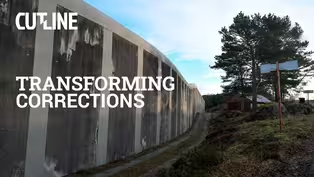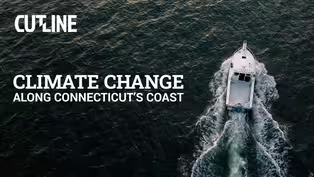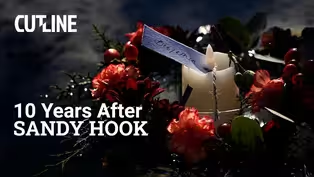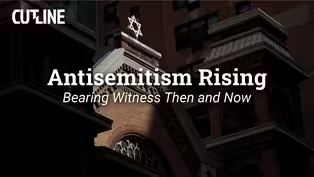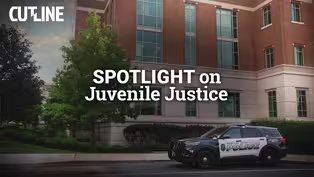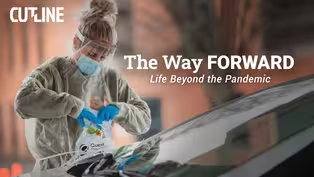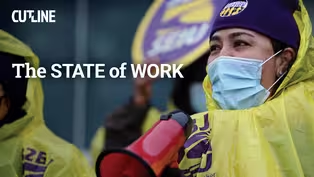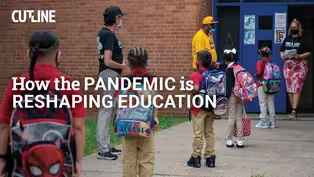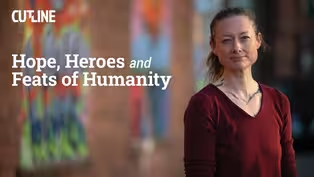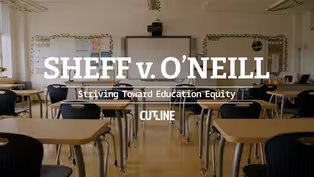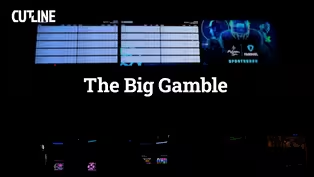CUTLINE
Los de Maria: Four Years After the Hurricane
Special | 53m 46sVideo has Closed Captions
Four years after the hurricane hit Puerto Rico, Los de Maria now live between two places.
It’s been four years since Hurricane Maria swept across Puerto Rico, forcing many puertorriqueños to leave their homelands to start new lives in New England. Los de Maria - the people of Maria - now live between two places. The island’s recovery is still not complete. And families are not done asking themselves, should we stay? Should we go back? Is this home?
Problems playing video? | Closed Captioning Feedback
Problems playing video? | Closed Captioning Feedback
CUTLINE is a local public television program presented by CPTV
CUTLINE
Los de Maria: Four Years After the Hurricane
Special | 53m 46sVideo has Closed Captions
It’s been four years since Hurricane Maria swept across Puerto Rico, forcing many puertorriqueños to leave their homelands to start new lives in New England. Los de Maria - the people of Maria - now live between two places. The island’s recovery is still not complete. And families are not done asking themselves, should we stay? Should we go back? Is this home?
Problems playing video? | Closed Captioning Feedback
How to Watch CUTLINE
CUTLINE is available to stream on pbs.org and the free PBS App, available on iPhone, Apple TV, Android TV, Android smartphones, Amazon Fire TV, Amazon Fire Tablet, Roku, Samsung Smart TV, and Vizio.
More from This Collection
Connecticut Public’s monthly deep dive into current issues, ideas and events that are most on our minds in Connecticut.
Video has Closed Captions
Explore how leaders and policy makers are trying to transform corrections in Connecticut. (47m 25s)
Climate Change Along Connecticut’s Coast
Video has Closed Captions
Learn about Long Island Sound’s importance and how its communities need to be protected. (51m 10s)
Video has Closed Captions
A look at the decade after Sandy Hook, and what has changed since the mass shooting. (53m 26s)
Antisemitism Rising: Bearing Witness Then and Now
Video has Closed Captions
Hear personal stories of the Holocaust and look at links between antisemitism & extremism. (57m 14s)
Video has Closed Captions
The Accountability Project takes a deep dive into Connecticut’s juvenile justice system. (56m 49s)
Video has Closed Captions
Learn how COVID and a collapsing childcare industry are impacting kids’ wellness. (57m 50s)
The Way Forward: Life Beyond the Pandemic
Video has Closed Captions
A look at the people and organizations helping shape life beyond the Pandemic. (57m 28s)
Video has Closed Captions
An exploration of the ways work has-- and has not-- changed as a result of the pandemic. (56m 17s)
How the Pandemic is Reshaping Education
Video has Closed Captions
We explore how the COVID-19 pandemic has reshaped education. (56m 40s)
Hope, Heroes and Feats of Humanity
Video has Closed Captions
Meet people from CT who’ve done audacious things over the course of a difficult year. (54m 28s)
Sheff v. O'Neill: Striving Toward Education Equity
Video has Closed Captions
Sheff v. O’Neill has created a model for school integration programs, and controversy. (55m 54s)
Video has Closed Captions
Connecticut has legalized sports betting. Where does the money go? What about the tribes? (53m 36s)
Providing Support for PBS.org
Learn Moreabout PBS online sponsorshipBRENDA LEON: It's been four years since Hurricane Maria swept across Puerto Rico, from the Southeast of the island to the Northwest.
The Category 4 hurricane destroyed homes, power lines, roads and left many without access to food, medicine, electricity, and clean water.
And the storm forcibly uprooted people from their homeland.
Many puertorriqueños left behind the lives they knew to create new ones in New England.
Welcomed by the Puerto Rican diaspora but faced with the challenges of displacement, without jobs, steady income and the cold winter, and in many cases without their loved ones.
Shortly after the hurricane, Puerto Rican government officials estimated that 64 people had died as a direct result of the hurricane, but a Harvard University study put that number at over 4,600 lives lost.
And the trouble continued.
A faltering economy, a toppled governor, earthquakes and now the coronavirus pandemic.
Leaving the island for the continental U.S. is not a new trend.
For decades puertorriqueños have come to Florida and the Northeast looking for employment opportunities in places like Connecticut, Massachusetts, and beyond.
In the decade beyond the storm, nearly half a million people left the island.
And according to the Center for Puerto Rican Studies at the City University of New York, an estimated 135,000 people have left the island since the storm.
Of those, an estimated 13,000 puertorriqueños came to Connecticut, leaving behind the beauty of beaches and the mountains in the middle.
They stayed in hotels, their children enrolled in schools, and now they live between two places.
Four years later the recovery is not complete, and families are not done asking themselves: Should we stay?
Should we go home?
Or is this home?
Los de Maria, the people of Maria four years later.
I'm Brenda Leon.
This is Cutline.
[baby cooing] - [wind rustling] - [rooster crows] Silence is horrible.
But it speaks to you.
It just screams, and you can run during the day, but in the silence of the night you can't hide from the things that you fear the most.
It just evokes things in me and in people in Holyoke, Massachusetts that's very close by, where a lot of Puerto Ricans came after the hurricane.
You know exactly the song you were listening to when the radio went dead.
I remember coming to Holyoke and the mayor being at the time Alex Morse giving me the key to the city, and as grateful as I was for that, what I remember about that day the most, is a little kid that came over and pulled on my pants and said: I am from Maria, yo soy de los de María, and to me, that, I mean it was so etched in my soul that I'm repeating it today.
Because that phrase: yo soy de los de María, "I am those from Maria", meant I had to leave what I know to come here.
At the beginning there were different ways of exodus.
At the beginning it was those who had money left.
They took their $2,000 charter flights and left.
Those who had money and homes here, vacationing homes, left.
Two is the ones who were here and there, the families were divided.
And the third one is the ones that left and came here, perhaps thinking it was a temporary situation, but then stayed and started making their lives here.
So the ones that had the least amount and no one to care for them, except for their neighbors or the government, were the ones that were left behind, and then about a year or two into it, there was a second wave, which was the professionals, the brain drain, the young people saying: "You know, this isn't getting any better."
In the last couple of weeks the department of HUD in Puerto Rico announced that it had only fixed six percent of the homes.
It is estimated that 300,000 homes from the hurricane alone, just think the two hurricanes, then the two earthquakes.
So from the hurricanes alone it was 300,000.
Six percent only had been fixed.
I am a Puerto Rican national and an American citizen.
Puerto Rico is a nation.
It's a colony but it's a nation.
So, I think Puerto Ricans here struggle with their nationhood, with: yo soy Boricua, para que tú lo sepas.
Sometimes I say I'm too Puerto Rican to live in the States and too American to live in Puerto Rico.
We almost live in a different-- in a land of two cultures.
We owe it to the memory of those that didn't make it to not be content with surviving, but to aspire to thrive.
And, you know, I say: Is it radical to want children to go to school and have a good education?
Is it radical to want to be treated with dignity?
Is it radical to want to have the energy and distribution in the hands of the Puerto Rican people?
And I don't want anybody, I don't care if you are a Republican or a Democrat, you don't deserve to die because your government turns their backs on you, and relinquish on their responsibility to take care of you.
How simple can that be?
To not have people die on your watch.
To not have people die on your watch.
Our lives mattered.
We mattered.
And he threw paper towels at us.
And as painful as that still is, it is the love of the people of the United States, de los latinos, de los boricuas, that keeps me company in that silence.
[♪♪♪] BRENDA LEON: South of San Juan, David Ocasio and Ana Maria Vasquez Escalante were among those offering to help after the storm.
They organized community kitchens, and helped families with basic needs.
During the pandemic the work continued.
Together they run Club Semillitas de Amor, a local organization that became one of the only centers in the area certified in emergency management.
We visited El Sector La Morenita where we met residents facing two challenges: fixing their homes and proving to the authorities that they actually owned them.
This house was affected by Maria.
If you can see it's still the same way, it took everything.
Since she started the process it's been more than two years.
But like I tell you it takes time, it takes time for them to show, prove that they live here.
Plus we got the pandemic.
Everything stopped with the pandemic, COVID-19.
So this has been very slow, but now we're starting to catch up.
BRENDA LEON: With donations and the help of Ocasio and Vasquez Escalante, seniors like Luminada Morales Rios and her brother Elias, have been able to make some repairs to their homes.
Other structures have been rebuilt through government programs.
But Ana Maria says even four years after the hurricane, there are still challenges.
BRENDA LEON: While people like Luminada Morales Rios had repair work done in her home, her bother Elias has been told by government officials that his home is not fit for rebuilding.
The structure needs to be torn down and rebuilt from scratch.
He says his only desire is to have a home before he dies.
Angel Morales is one of the thousands of people who live in what began as squatter settlements and over time have become communities.
BRENDA LEON: When the hurricane hit, Jose Luis Camacho lost everything.
For the past four years he's been living in a shack across the street from what used to be his home.
With the help of community leaders like Aileen Rivera, Camacho will finally own a home nearly four years after the hurricane.
BRENDA LEON: When Maria hit Puerto Rico, it left the island without electricity and cell coverage.
Many of the lives lost after the hurricane were due to the lack of access to medical care and an inability to call for help.
In Utuado, residents lived without electricity for almost a year.
We stopped by Barrio Canillas where part of eye of the hurricane passed where we met with Jorge Perez Heredia, the current mayor.
He says the town is still affected by landslides that make transportation not only difficult but dangerous, and residents in this central mountainous region are still living without unreliable electricity, making it harder to get clean water.
Perez knows the challenges firsthand.
He's a former supervisor of the Puerto Rico Electric Power Authority, the government-owned company responsible for electricity generation, distribution and transmission that is not longer in control of the electric grid.
And the rising costs means Utuado needs a lot more money than he's getting from the federal government.
BRENDA LEON: Perez says he's also dealing with the reality that people are leaving Utuado and the island itself.
By 2018 it was estimated 5.5 million Puerto Ricans lived in the United States and 3.4 million on the island.
That's according to the Pew Research Center.
BRENDA LEON: Some estimates show that nearly quarter of the island's schools didn't reopen after Maria.
A lot of those students found themselves elsewhere, including Connecticut.
In Hartford superintendent Leslie Torres-Rodríguez said the district enrolled 457 students in Hartford Public Schools shortly after the hurricane.
I spoke with Torres-Rodriguez while she was on the island reconnecting with family.
Watching what was unfolding with the hurricane, we knew, I knew, I knew, that we would have students enrolling in-- we would have students and families enrolling in our schools.
I just knew that they were going to come with family.
And Hartford being a gateway city, and having such strong ties to the Caribbean, especially Puerto Rico, we immediately activated.
And I thought back to my own experience, what it is for in my case a nine-year-old that already had solids, solid ties and structure here at home, and what that means and what that feels and looks and sounds like.
Every time I come back home I can't help but to think about when I left.
And so at the age of nine, leaving your motherland, leaving your family, your network of support, your peers, the culture.
So it always, all of those things come back.
Those thoughts, those feelings, those emotions come back, but if I think about the last four years, a lot of thought as to our students, especially the students, the 457 students that we welcomed as a result of the aftermath of the hurricane.
When I applied my own lived experience minus a hurricane, that was not my lived experience.
My experience was having to move and leave and go, and live in a very tight living quarters with distant relatives and experiencing the seasons.
Oh my goodness, the leaves are falling from the tree.
Oh, a couple of months later snow is falling from the sky.
Oh, we don't go to school on heavy snow days?
All of those nuances.
But then it's the deeper challenge for a student which is you know completely feeling that you don't belong, and one of the reasons is language, right?
Feeling like you can't communicate verbally.
We know that students and families have a higher level, a deeper level of need.
And so we have to solve for that, and that means that, in some communities, in some schools, additional resources are a must.
Of the 457, 171 students have remained with us in Hartford Public Schools.
one of the things that we learned when we kind of looked back at lessons learned from our response to serving the students that we welcomed after the hurricanes, was that supports, community based supports were key, were at the center of our students and our families feelings supported.
And so that's something that I think is still important moving forward, because when our students do come to the mainland, they of course are going to access support in school, but we know that it's not just the student, we know that it is the family, right?
We know that housing insecurity -- I mean housing, as you well know, was the recurring challenge that we heard from the families that were displaced, even when they came to Connecticut, to Hartford, right?
And so, those are still true for families that, you know, come to Hartford, making sure that housing is established, making sure that food-- food insecurity was another one, and providing for medical supports, and access to medical care.
And so, it is ensuring that there is what I call the ecosystem of supports for students and for families.
Do you expect to continue to receive families and students from Puerto Rico?
Yes, we always do.
Natural disasters aside, we continue.
We are a gateway, and we have, if I recall the data correctly, a few years ago, a third, or maybe 25% to 30% of the population in Hartford was Latino and in Hartford Public Schools 55% of our students are and the majority are from Puerto Rico and so for us it is part of who we are.
And it is without a doubt connected to our mission to make sure that we provide for each and every one of our students.
[baby crying]

- News and Public Affairs

Top journalists deliver compelling original analysis of the hour's headlines.

- News and Public Affairs

FRONTLINE is investigative journalism that questions, explains and changes our world.












Support for PBS provided by:
CUTLINE is a local public television program presented by CPTV
